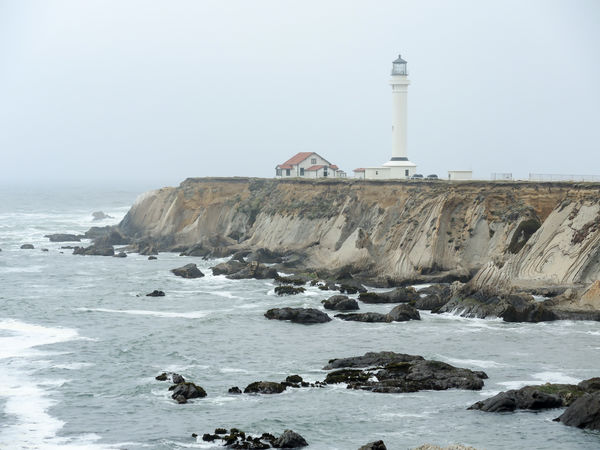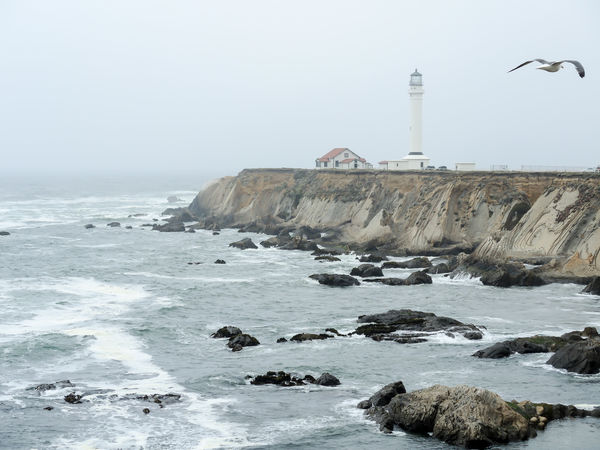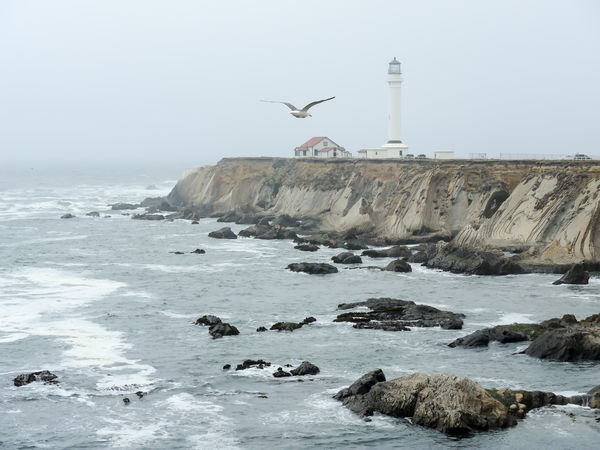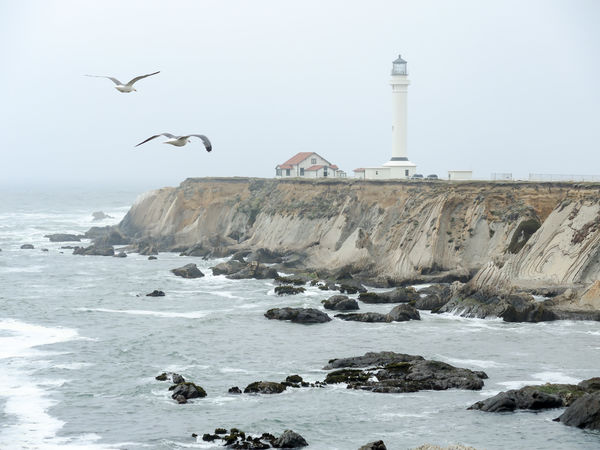Re: Editing, Ethics, Crows, Seagulls, and Fishermen
Aug 19, 2016 22:46:32 #
A somewhat off-topic discussion got started over on Frank2013's thread. He said he didn't mind, but the discussion of course got buried, so maybe it's good to give it its own thread.
The question I raised was about finishing, specifically whether to remove or not remove a pole. Back in the day pretty much the choice would be between leaving it in or cropping it out. I liked Frank's picture cropped as it was, and so did he (!), but I admit that I didn't care for the pole, but I would not like to change the composition with a crop to get rid of it. Of course, the third thing is to clone it out. It's something of a philosophical question: should we because we can? "Back in the day," other than cropping, we'd have to take an airbrush to that pole, then make a copy negative and print from that. My experience always was that that was to be avoided because the second generation was never as good. Now we can remove the pole seamlessly without harming the composition, but must we remove it because it's a minor distraction? I know that working for some news organizations altering a picture can get you fired. Obviously, this is not that, buuuuuuut...
Linda from Maine remarked that she'd just made a sunrise that she would have loved to have had a convenient flock of crows fly in. If I had made that sunrise and I had a handy flock of crows in my files I don't think I'd have much compunction about putting them in, up right, flying right to left, maybe 5 or 6 of 'em. We also just had a recent discussion (argument?) over the propriety of adding clouds to a blank sky (I personally have no problem with it).
It isn't necessarily about the ethics of doing so (although I have often seen reasoned ethical arguments against post-processing in general and image alteration in particular), but rather more, maybe, the wonder of what we can do and, also maybe, if there is an ethical line? I take stuff out of pictures all the time if I think they distract from the main subject. I dodge and burn and sharpen and blur and vignette, but I did all that in my wet darkroom. It was even possible to double-print in, say, a flock of crows, but that also would be a master print that then had to be copied because trying to make a print run double-printing all of them was pretty tedious. But prints from a copy negative, no matter how good, were never as sharp or crisp as the master.
Over in our new invitation-only Digital Art section, we seem to be gravitating strongly toward the art of photomanipulation, which since the relatively recent advent of Lightroom and Photoshop and Corel Draw and others have brought it within reach of people (like me!) who before could not have dreamed of being able to do the stuff we can do now. And it gets easier all the time. I LOVE it! And have few scruples about using it. I have more than once added or moved a bird that was needed, or in the wrong place (stupid birds).
.
The question I raised was about finishing, specifically whether to remove or not remove a pole. Back in the day pretty much the choice would be between leaving it in or cropping it out. I liked Frank's picture cropped as it was, and so did he (!), but I admit that I didn't care for the pole, but I would not like to change the composition with a crop to get rid of it. Of course, the third thing is to clone it out. It's something of a philosophical question: should we because we can? "Back in the day," other than cropping, we'd have to take an airbrush to that pole, then make a copy negative and print from that. My experience always was that that was to be avoided because the second generation was never as good. Now we can remove the pole seamlessly without harming the composition, but must we remove it because it's a minor distraction? I know that working for some news organizations altering a picture can get you fired. Obviously, this is not that, buuuuuuut...
Linda from Maine remarked that she'd just made a sunrise that she would have loved to have had a convenient flock of crows fly in. If I had made that sunrise and I had a handy flock of crows in my files I don't think I'd have much compunction about putting them in, up right, flying right to left, maybe 5 or 6 of 'em. We also just had a recent discussion (argument?) over the propriety of adding clouds to a blank sky (I personally have no problem with it).
It isn't necessarily about the ethics of doing so (although I have often seen reasoned ethical arguments against post-processing in general and image alteration in particular), but rather more, maybe, the wonder of what we can do and, also maybe, if there is an ethical line? I take stuff out of pictures all the time if I think they distract from the main subject. I dodge and burn and sharpen and blur and vignette, but I did all that in my wet darkroom. It was even possible to double-print in, say, a flock of crows, but that also would be a master print that then had to be copied because trying to make a print run double-printing all of them was pretty tedious. But prints from a copy negative, no matter how good, were never as sharp or crisp as the master.
Over in our new invitation-only Digital Art section, we seem to be gravitating strongly toward the art of photomanipulation, which since the relatively recent advent of Lightroom and Photoshop and Corel Draw and others have brought it within reach of people (like me!) who before could not have dreamed of being able to do the stuff we can do now. And it gets easier all the time. I LOVE it! And have few scruples about using it. I have more than once added or moved a bird that was needed, or in the wrong place (stupid birds).
.
We were at Two Harbors MN on Lake Superior. Amazingly there were TWO 1,000-footers, one backing out, the other coming in. The weather was bad, the light was bad, but I wasn't going to let that stop me. I banged away with my little Nikon P7800.

(Download)
BUT I liked the relative positions of the incoming and outgoing boats better in this shot, but by that time the fishermen had disappeared.

(Download)
SOoooo - I borrowed the foreground and fishermen (resized and repositioned) from the first shot in order to get the final version. This is not for commercial or press use, so why not?

(Download)
2014, Point Arena Light, California coast. Funny thing about weather and me; I arrive as the fog is coming in and anyway the lighthouse is closed. Am I gonna let that stop me? Not on your tintype.

(Download)
Ah! A seagull drifts into frame... TOO FAST! COME BACK!

(Download)
But seagulls are like buses; there'll be another one along any minute, but also probably going too fast!

(Download)
Okay, so ethics shmethics. I liked my first frame best but it needs a seagull. No, wait, it needs TWO!

(Download)
Aug 19, 2016 23:21:07 #
Interesting questions. I have no qualms about removing distracting elements, especially power poles in landscapes, trash in landscapes etc. Many times no one knows but the photographer. I have a portrait of a cow that was just awarded an honorable mention at our state fair. I had to give that cow a makeover, as it was covered in flies and it looked like she'd stuck her face in a bale of hay. She ended up looking pretty good and no one needed to know what a mess she was. Now, I may be spoiled since I never experienced film and darkroom work. As far as adding something to an image, I don't have the capability to do that and I'm not sure I'd have the creativity to pull it off if I did.
Walt
Walt
Aug 19, 2016 23:49:44 #
Aug 20, 2016 00:06:26 #
I have no qualms about removing distractions, cropping out "stuff", adding things either. I make composites without the slightest twinge of guilt. I don't have any disclaimers posted by the images on my gallery wall. I don't enter images with things added or removed into contests that forbid such as that, I go by the rules. If people ask me something about an image, I answer truthfully.
I've always felt that if I buy my own camera, computer, and software, pay for my own printing, spend my own time doing all that stuff, I can do whatever the heck I want to with it.
I've always felt that if I buy my own camera, computer, and software, pay for my own printing, spend my own time doing all that stuff, I can do whatever the heck I want to with it.
Aug 20, 2016 01:29:58 #
I have a practical question.
Chuck_893: am I correct in thinking that you used copy-and-paste to put the boat from the first picture into the third picture? I ask because when people want to remove something from a picture, such as a boat, or a pole, they seem to always think of using the clone tool; is there some good practical reason for using clone to accomplish that task rather than using copy-and-paste to move "emptiness" or simply painting "emptiness" {if you have a featureless sky and want to remove a pole or a stray airplane, for example}.
Chuck_893: am I correct in thinking that you used copy-and-paste to put the boat from the first picture into the third picture? I ask because when people want to remove something from a picture, such as a boat, or a pole, they seem to always think of using the clone tool; is there some good practical reason for using clone to accomplish that task rather than using copy-and-paste to move "emptiness" or simply painting "emptiness" {if you have a featureless sky and want to remove a pole or a stray airplane, for example}.
Aug 20, 2016 07:39:32 #
Whuff wrote:
Interesting questions. I have no qualms about remo... (show quote)
Thanks for looking in and commenting, Walt. I've been doing some reading on the subject and am coming to the conclusion that it's news versus art photography, and few of us are newspicture photographers. In 2014, Pulitzer-prize winning photographer Narciso Contreras was fired by the AP because he cloned out a distracting element in a picture. Another photographer's camera was in the lower left corner of the shot and Contreras cloned it out as a distraction. If the camera had been further to the left he could have cropped it out and no one would have said boo, for the reason that cropping has long been accepted. The camera itself crops any scene. But Contreras committed the (at present) unpardonable sin. It is a very interesting question.

Aug 20, 2016 07:40:34 #
Frank2013 wrote:
I'll just say it's your photo do what you want.
Thanks, Frank. That's my thinking.

Aug 20, 2016 07:42:11 #
Aug 20, 2016 08:08:25 #
Thanks so much for starting this topic, Chuck!
As a viewer, and this is a very generalized statement, I don't want the story changed to such a significant extent that I feel deceived.
Example: if someone says they hiked 10 miles into wilderness and stayed awake all night in freezing temperatures to get the shot, I don't want to find out after-the-fact that they added a gorgeous full moon from another image.
As a nature lover who has been fortunate enough to experience fleeting and awe-inspiring moments, I want to connect with the photographer's experience, and maybe dream it could some day happen to me.
As a photographer, I can appreciate a composite as art - but I want to know it is what it is.
It's a bit grayer area for me with lesser composites such as your gulls. I think in a photo forum such as this it would be appropriate to mention. On the other hand, I wouldn't care if you didn't inform me you'd cloned out a wire or bit of trash.
Guess it mainly comes down to the degree of the adjustment. But I'm sure there are plenty of exceptions people could throw at me that destroy my argument
As a viewer, and this is a very generalized statement, I don't want the story changed to such a significant extent that I feel deceived.
Example: if someone says they hiked 10 miles into wilderness and stayed awake all night in freezing temperatures to get the shot, I don't want to find out after-the-fact that they added a gorgeous full moon from another image.
As a nature lover who has been fortunate enough to experience fleeting and awe-inspiring moments, I want to connect with the photographer's experience, and maybe dream it could some day happen to me.
As a photographer, I can appreciate a composite as art - but I want to know it is what it is.
It's a bit grayer area for me with lesser composites such as your gulls. I think in a photo forum such as this it would be appropriate to mention. On the other hand, I wouldn't care if you didn't inform me you'd cloned out a wire or bit of trash.
Guess it mainly comes down to the degree of the adjustment. But I'm sure there are plenty of exceptions people could throw at me that destroy my argument

Aug 20, 2016 08:10:30 #
rehess wrote:
I have a practical question. br br b Chuck_893 /... (show quote)
Thanks for looking in! Yes, the boat was copied and pasted, as was the shrubbery along the bottom, both from the same shot. I was hand-holding so my framing wasn't consistent. The copy-and-paste in Photoshop placed each on its own layer. I did some edge refinement on the shrubbery. The boat was roughly selected with a lasso, including the wake right to the edge of the original. I copied the pixels and pasted them, then adjusted the size and positioning. There was quite a bit of matching to do with the boat and its wake, some of which was complex and might be done easier if I had a clue what I was doing. 😂
I imagine there are different ways to accomplish the same thing. A lot must depend on the tools. I started with Photoshop Elements 2.0 and bought a Dummies book to learn how to use it. I guess it was pretty primitive (they're up to what, 14 now?) but I could not believe what it could do. Sometimes I did things that I later learned I hadn't done "right" but they worked anyway. So sure, there's more than one way to do the same thing, such as simply painting over something in a clear sky. For that I might sample the sky area near the stray plane, then use a soft brush to paint over it. But I think that's basically what the clone tool, or the healing brush, does without the extra step. If there's any texture or detail near the area you want to remove, cloning or healing may be a better bet.
I don't know what programs you use, but I've gone whole-hog with Creative Cloud and "Full Dress" Photoshop. I think the higher number Elements have many of the same tools, like Content Aware Move and Patch, tools that can pretty seamlessly remove or replace stuff, but my experience (and I am NOT an expert!!!) is that there is often a workaround that can accomplish what you want. It doesn't even have to be an Adobe product.

Aug 20, 2016 08:30:19 #
Linda From Maine wrote:
Thanks so much for starting this topic, Chuck! br ... (show quote)
Hi Linda! Yes, I think there are degrees and gray areas. I started a while back noting in my captions on my Flickr pages if something has been "substantially" altered, such as the added seagulls or a sky full of clouds that weren't there.
Removing stuff can be ethically tricky. I have removed telephone and power poles, fences, even a big white shed on an otherwise pristine tree line, all because I thought they were at best distractions and at worst just ugly. We see all the time comments on submission suggesting "I would remove the [ insert perceived distraction here ]". That's what started this conversation, whether Frank should or should not remove a pole in his picture. It was what got me thinking about "back in the day" when it wasn't as duck-soup easy, about 30 years ago.
Aug 20, 2016 08:33:57 #
Chuck_893 wrote:
...Removing stuff can be ethically tricky...
And thinking again about the deceit of "significantly altering the story" - if you remove an adult from a scary/dangerous/lonely scene so that it looks like a child is all alone, the impact for the viewer is obviously much different.
Aug 20, 2016 08:40:59 #
Excellent thread Chuck !!! I have no problems adding or removing distracting elements from an image. For me and I'm sure for others as well it all depends on the scene at hand. At most though I usually leave an image as is unless it really is too distracting. I feel its no different than an artist/painter, just different tools at hand.
As a lighthouse lover, I simply love your lighthouse images. With and without the seagulls.
Dave
As a lighthouse lover, I simply love your lighthouse images. With and without the seagulls.
Dave
Aug 20, 2016 09:01:10 #
Dave Chinn wrote:
Excellent thread Chuck !!! I have no problems adding or removing distracting elements from an image. For me and I'm sure for others as well it all depends on the scene at hand. At most though I usually leave an image as is unless it really is too distracting. I feel its no different than an artist/painter, just different tools at hand.
As a lighthouse lover, I simply love your lighthouse images. With and without the seagulls.
Dave
As a lighthouse lover, I simply love your lighthouse images. With and without the seagulls.
Dave
Thank you Dave! I'm a lighthouse nut too. Trying to think ethically, however, I believe I can defend the seagulls (if such defense were needed) on the principle that they were there, they just weren't where I wanted them. If they hadn't been there I might have just settled for that first shot, but when one came drifting in out of the corner of my eye I grabbed for him but he was already too far into frame, so I kept trying to get one in the compositionally perfect spot but you know how tricky that is. When I got home I decided that, since they'd been there and had been legitimately caught in the same frame with the lighthouse, it was not unethical to move them around and even add one to a picture.
Linda mentioned that she would not like to be fooled by someone who pastes in a full moon and doesn't reveal that it was added. I tend to agree, but then I waffle when I think about the painter who paints the scene - and adds a big full moon that wasn't there.
 One reason I started adding "full disclosure" statements to my Flickr pix is that I've seen folks get pretty belligerent when they feel deceived, but how can you possibly know what a painter has been up to?
One reason I started adding "full disclosure" statements to my Flickr pix is that I've seen folks get pretty belligerent when they feel deceived, but how can you possibly know what a painter has been up to?Aug 20, 2016 09:15:14 #
Linda From Maine wrote:
And thinking again about the deceit of "significantly altering the story" - if you remove an adult from a scary/dangerous/lonely scene so that it looks like a child is all alone, the impact for the viewer is obviously much different.
Boy, now that's an ethical dilemma. There I tend to think "newspicture," and as I linked above someplace, Pulitzer-prize winning photographers have been censured and even fired for altering a news picture, even minimally. But - imagining this scenario, if the adult is far enough from the child to be cropped out, everyone seems to agree that cropping is legitimate but cloning is not!
Nick Ut in 1972 famously made the heartbreaking picture of 9-year-old Kim Phuc with her clothes burned off in a napalm attack, running screaming toward him. The original frame shows another photographer walking on the roadside apparently reloading a camera. By the time the picture was published the frame had been cropped from right to remove the other photographer. I've seen discussions about whether it was ethical to crop the other guy out because he was another adult, close to the child, but ignored her screams while tending to his camera. But Narciso Contreras was fired by the AP for cloning out another photographer's camera even though it had nothing to do with the news value of the picture.
If you want to reply, then register here. Registration is free and your account is created instantly, so you can post right away.



